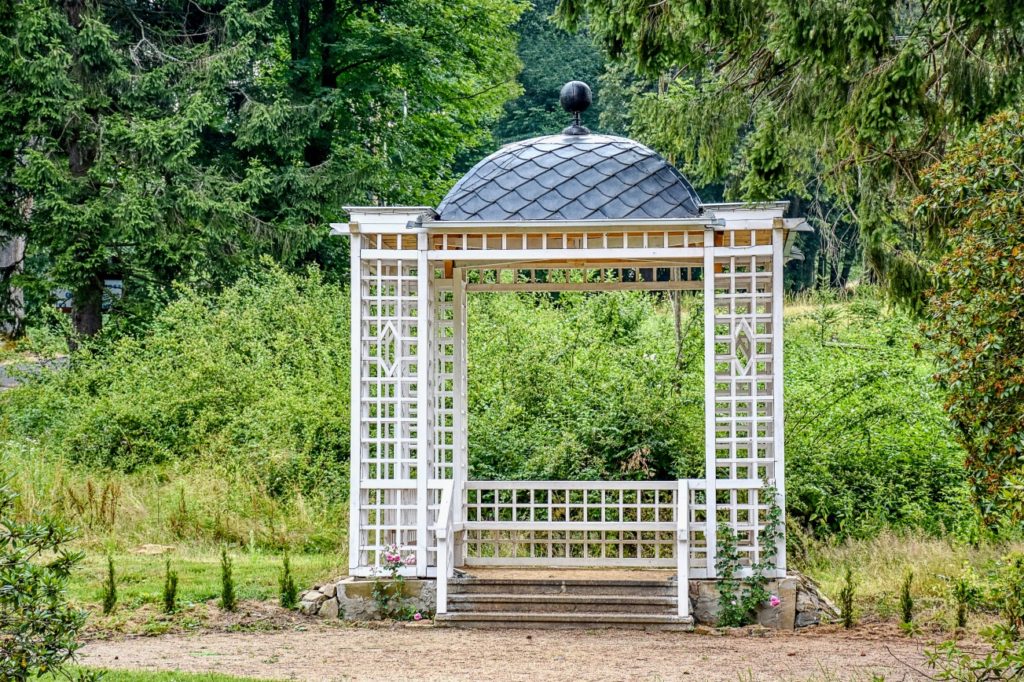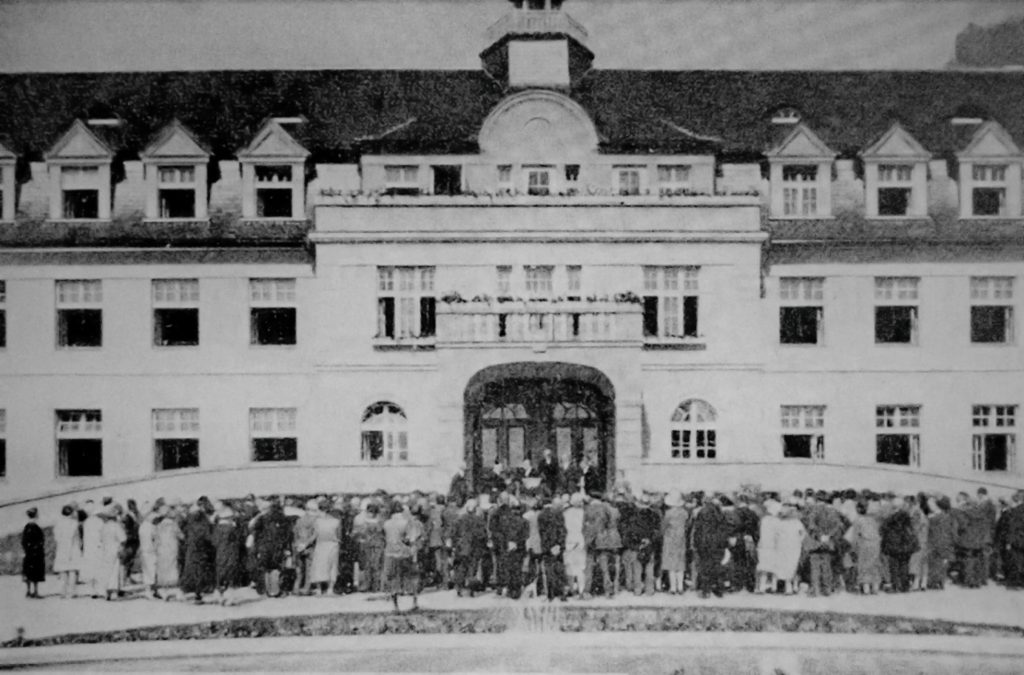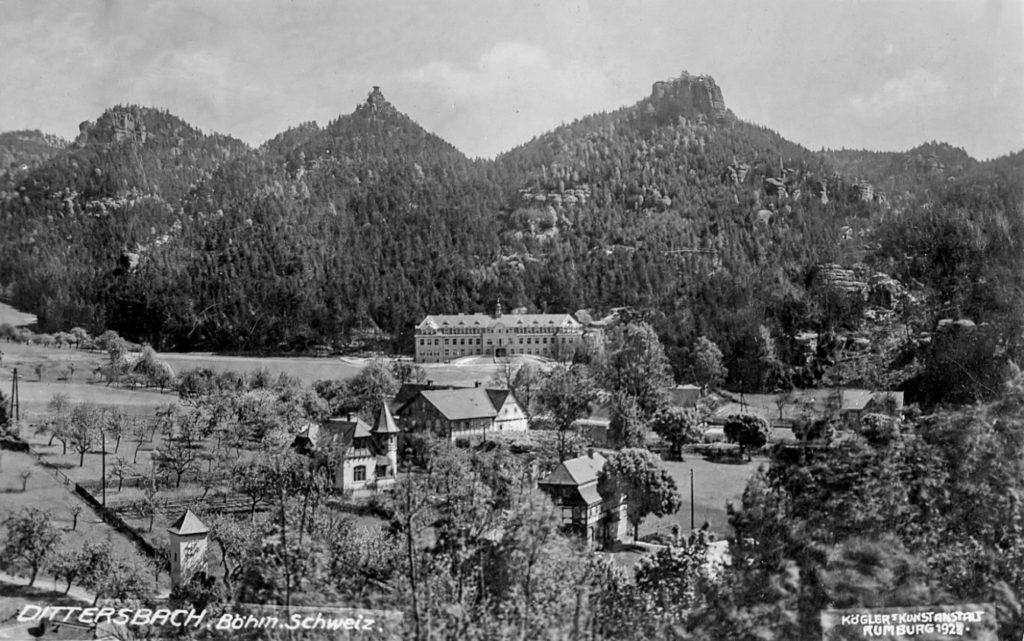Czech Switzerland is called the New Zealand of Europe. That’s right – you’ll find almost everything from natural beauty to everything in such a small space that it takes your breath away. And yet this area lacks something – a spa. But, is it quite true? In this Scapular, we will follow in the footsteps of spas and health care in the region. It will be a varied and often surprising journey. After all, let’s start with the fact that if any area in the Czech Republic is suitable to be designated as a climatic spa, then the mentioned region certainly is. The remarkable mixing of air currents, which is intensified by thermals around the table mountains, can blow air from as far as the North Sea into the rocks here. The bottoms of ravines and gorges in turn exhale icy and humid air, with a little exaggeration – almost arctic. The air here heals, there can be no doubt about that. The area around the table mountain Děčínský sněžník is even called a “wind spa”. In addition, those who manage to take advantage of the days when crowds of tourists do not flock to the magnets of the local landscape, or who are able to bypass the over-the-top places and go to areas that are not mentioned in every guidebook, are rewarded with a peace that can be cut and a silence that seems to come here blown from the past. For example, people from Doubice fondly claim that their village is a “brain spa”. So come and look into the history of the journey to human health here.

Well – and then there were no spas in Bohemian Switzerland! They were. Count Jan Josef Thun-Hohenstein, under the impression of strong experiences from Karlovy Vary, very much wanted to have a healing spring on his estate and to build a spa. He lived to see it in 1768, when his gamekeeper discovered a spring of ferruginous water in Horní Žleb. The analysis showed that it is a very beneficial, even healing water, suitable for baths and helping to treat constipation, flatulence, golden veins, menstrual problems and even mental retardation…

A year later, the first temporary house appeared near the spring, and the spa was opened in 1777 in a new brick building. In front of the building stood a fountain with a statue of Neptune, which is still deposited in the Děčín museum. The spa happily prospered, even so much so that the next owner of the Děčín castle, František Antonín Thun, decided to expand and rebuild it. Horní Žleb grew – there were new inns, boarding houses, hotels, private villas, steamships landed here, František Palacký and Crown Prince Rudolf and Princess Stefania were treated here…

The development of the railway and catenary steamships brought excessive noise and paradoxically meant the decline of the spa, so the Thunes sold it in 1906, only for the spa to close completely in 1922. This is what the former spa building looks like today. So the end of the only spa in Czech Switzerland?

Yes, but it didn’t have to be. Another spa project matured in the unusually active and creative head of Prince Edmund Clary-Aldringen, owner of the Bynovec estate, which also included the rocky area between Hřensk and Vysoká Lípa. In 1892, he started building a spa hotel in a secluded area called Mezní louka, where until then there was only a forest house and a small boarding house. Climatic and hydrotherapy baths – that was the intention. The building was – and is – sumptuous, in the Alpine style, but the attempt to use the local springs did not lead to success, so the spa was rebuilt into a sumptuous hotel with rooms, salons, a library, a reading room and a smoking room. At least the salt baths that were available to guests remained of the spa idea.

The interest was huge, the princely family, their friends and the richest clientele who came to admire the wonder of the world, Pravčická brana, stayed there. In the same year, Edmund also had the path around the foot of the rock walls leading under Pravčická brána modified (it had already been laid out and built around 1880) and he named it after his sister Leontina Gabriele – Gabriela’s path. As can be seen from the picture, the hotel hasn’t changed that much in more than a hundred years. So from the outside…

Let’s continue to the Czech Netherlands, because a spa project was created here as well. Within sight of Šluknov, in a charming valley sloping down to an unnamed stream, during the construction of the railway between Šluknov and Rumburk, wooden quarters for Italian workers grew. When the workers had left, one morning a respected citizen of Šlukno, the baker Karl Schütz, was walking by. He got an idea. And he was willing to invest in it. It was so beautiful here. And the peace. And the air!

As early as 1887, the “Blue Ball” inn grew up under the care of Mr. Schutz, and when it became clear that the people of Šluknov liked to direct their Sunday steps here, more and more buildings began to be added. Artificial ponds, a Chinese pavilion, gazebos, promenades, terraces with sunbeds, even a forest theater. The popularity of the place grew, soon it was discovered by people from more distant places, who found it worth going to the resort, which was increasingly talked about.

The place got its name somehow by itself – it was simply Karlthal, Karl’s Valley, because it really belonged to Karl, and he was the one who was able to transform the forest wasteland into a magical place full of light and joy. In 1912, a major turning point occurred – the town of Šluknov bought the place and started investing. Two years later, a spa hotel was inaugurated here and the place was declared an airy, today we would say climatic, spa. Richer clientele from Germany, but also from more distant places, started coming here. Karlova údolí was simply in vogue, which did not abate throughout the twenties and thirties.

Not even the Second World War took away its popularity, it just turned into a recreation and treatment center for the German army. After the war, Karlovo údolí was used by the Transport Company of the Capital City of Prague, which began to use the area as a recreation center for its employees. Since then it has been called – at the Castle. The fifties were beginning.

The castle had thirty rooms, a dining room, a theater hall and later even a wine bar. In the early years, a park with a gazebo still functioned, boats plied the lake, and volunteers from Šluknov played in the forest theater on Sundays. However, the transport company, in the spirit of the national crisis, only used the site. He didn’t repair, he didn’t invest. When it falls, we will go elsewhere, was the philosophy of the time.

Only in 1990 did repairs begin, but part of the “castle” collapsed, so after four years the work stopped and was never resumed. Since then, both the building and the park had fallen into a pensive state of disrepair, the roofs were falling in, and it seemed that the forest would soon take back what had once belonged to it.

The former glory has withered, few people wandered here anymore – and when they did, he was in tears. Until two dreamers appeared.

Martin and Ema Bilinski. In 2016, they bought the Charles Valley and some sage waved their hands over them or slapped their hands.

New owners, although they are no zobanci, apparently want to return Charles Valley at least dignity. And so the area was cleaned, air raids and all sorts of elent were taken and the building got its space again. And suddenly it’s a much more positive spectacle than a few years ago. A bit…

The work has been done a lot in recent times. With the knowledge that all of this are all two people with the help of friends, occasional voluntary temporary workers and participants in benefit events – it is breathtaking. It was beginning to convert the jungle into an area with which something could be done. Then the cultivation of the former park in front of the hotel started.

A copy of the original gazebo became the centerpiece and the symbol of the reventers of Charles Valley.

That’s how he looked once…

… And now. Is beautiful. The tiny thresholds set in the spirit of the original form on both sides began to take strength. Once in front of their high bodies, white benches will be standing – even the biggest mischief will be believed today.

And maybe a meadow will come to life in sight of the hotel…

… And maybe we will have a beer and a good lunch once again…

… And we will ride on the boats. There is no choice but to hope and keep your fingers crossed. And even here and there to put your hand to the work on occasional brigades.

In our wandering over time and finding traces of efforts to improve the health and mental condition of people, we have reached Jetrichovice, where still uninformed visitors are amazed by the building of the chateau proportions and a bit of appearance. Abandoned children’s sanatorium.

In the 1920s, trying to build a recovery in northern Bohemia, which would to some extent demonstrate the viability and social empathy of the young republic, a generous facility similar to those that were scattered in climatic fabric places throughout Europe. It has been looking for a long time, but when the commission in the summer of 1924 came to a tour of the Jetrichovice meadows under the raven rock, perfectly covered from the north by the massif of the Jetrichovice views, from the south open to the sun, surrounded by rocks and forests – it was decided.

A year later, an architectural competition was announced, which did not go well. None of the nineteen proposals fit the purpose – childcare. The impasse was solved by a practitioner – construction manager Ludwig Parche, who sat down and created a project that seemed ideal. Construction began. The construction costs rose to 2,700,000 crowns, and the total cost of the rehabilitation center was 10 million Czech crowns. And so on Saturday, September 3, 1927 (less than two years after the start of construction!) the convalescent home could be ceremonially opened.

The fact that the President of the Republic, Tomáš Garrigue Masaryk, cut the ribbon also testified to the importance of the object and its use. The chronicler of Srbokamenick, in an elevated language, recorded in the municipal annals the fact that “never before has such a crowd of visitors flowed, and even Jetřichovice has never experienced such a large influx of foreigners.”

The building, which had a really castle-like, massive impression, was very rationally and actually simply structured. On the ground floor, a generous games room and dining room. Upstairs there are laundry rooms, dressing rooms, washrooms, toilets and, above all, bedrooms for one hundred and fifty children. In the attic, there is a warehouse, apartments for teachers, isolation rooms and rooms for the mildly ill, apartments for employees with accessories. And by the way – there was – and is – a swimming pool in the basement, and another one outside.

Over the years, since the sanatorium was closed and offered for sale only in 2005, thousands of children have taken turns here on healing and relaxation stays. For fifteen long years, however, the building gradually fell into disrepair. The business plans did not succeed, and the idea of many locals that with the help of the state the building could be returned to its original purpose and that it would in turn serve children or perhaps the elderly, despite the efforts of some particularly devoted personalities (I would like to name professor Stanislav Tůma, M.D., and his the wonderful woman Jitka Tůmová), also failed to finish.

What does it look like today? In some places, actually better than one would expect. (Thank you for the photos to Vít and Monika Míková.)

But most of the time is the tooth of time – and probably even non -people – to see better than one nice. (Thank you for the photos to Vít and Monika Míková.)

When the fate of the recovery seemed to be similar to the fate of many interesting industrial, sacral and profane buildings in the region, an investor appeared in the area and operates several accommodation and restaurants. He came up with the idea of commercial use.

Within five years, the building of the former sanatorium should be reconstructed, and with an emphasis on its historical value. Next to it, a modern building will grow and the whole area turns into a hotel. A ground -floor restaurant will be built in front of the sanatorium. It should open up on the occasion of the 100th anniversary of the building. By the way, September 3, 2027 is based on Friday. So that’s the plan.

Hope is aroused by a team of architects, because the Hoffman studio has significant and remarkable and award -winning projects – such as Poštovna Anežka in Sněžka, but also a major implementation on the border of Czech Switzerland and the Czech Netherlands – Aparthotel Lípa and the Falkenstein brewery in Krásha Lípa.

We all have different aesthetic feeling, we all have different ideas about the use of historical buildings, especially those built with the social aspect. But the time is what it is, and whatever opinions we are, we probably agree that the rescue of a remarkable building is definitely good news.

We are at the end of the pilgrimage of history, present and hopefully the future of buildings that have to do with human health. We deserve rest. Let us return to where we went from crystalline peace, beauty and purity. Bohemian Cottage is also a kind of recovery or recovery, both body and soul. So let’s drop the steam and let us pamper.
Whirlpool. The vibrating water hugs the body and drives fatigue. Day and night. It’s relief, it’s cleansing… We’re nice.

It would still want to warm up the body, fill it with the heat that lasts… The sauna is ready.

Yoga. Four letters for the body, soul, balance, reconciliation with the world. Injection of positivity. The way to how to love your body. Let’s go…

Jezírko. Motýli a vážky. Spočinutí v chladivé vodě. A sluneční koupel. Klid…

In the summer into the water, in winter from the water – yes, here it is possible.

It is evening, the cold clutches the landscape. Steam rises from the hot water barrel. The noisles of the season are just dominating, the barrel attracts like a magnet. So let’s and plunge up to the neck. A glass in your hand and we can talk. For example, how people have been trying to take care of their physical and mental health for centuries. And what we have experienced on the pilgrimage for the monuments of this effort today. Or what else will be about the eighth roar…
Written by Rostislav Křivánek
Other articles from Škapulíř can also be found on our blog.
Published on: 15.1.2024 - Filed under: Blog - Tagged: Competition, The Scapular

